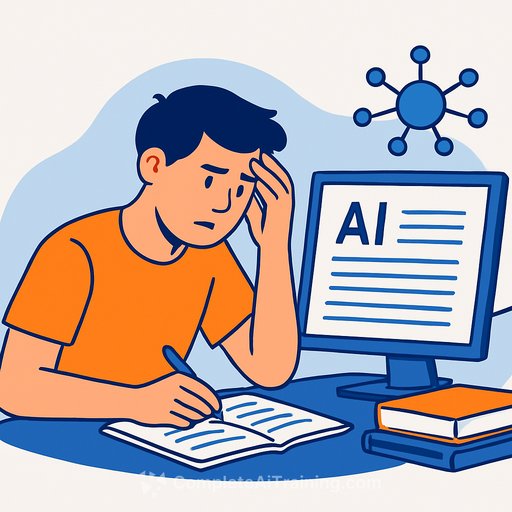Memorised AI essays: the shortcut that backfires in VCE (and in professional writing)
Teachers at a top Melbourne school say around half their students plan to walk into VCE English with memorised, AI-written essays. On paper, it sounds efficient. In practice, it's a marks killer - and the same trap burns working writers.
Here's why the shortcut fails, and a smarter way to use AI without losing your grade, your voice, or your credibility.
Why memorised AI essays fail
- Prompt mismatch: VCE prompts are specific. A pre-written essay rarely fits cleanly, so you drift off-topic and get penalised.
- Generic voice: AI defaults to safe phrasing and clichés. Markers (and editors) can smell it. It reads like filler, not thinking.
- Thin evidence: VCE English expects precise references, analysis, and logical development. Stock essays often skip text details or fake them.
- Style tells: Over-smooth transitions, repetitive structure, and vague claims. Even if detectors aren't reliable, humans notice.
- Stress tax: Reciting a script under pressure is brittle. One twist in the prompt and the whole plan collapses.
If you're sitting VCE, your best guide is the official criteria and assessment advice. Start here: VCAA assessment.
A smarter tactic for high-stakes writing
Memorise moves, not essays. Build a small toolkit you can adapt on demand. That's how you survive curveball prompts - and how pros ship on deadline without sounding like everyone else.
A minimal framework that holds under pressure
- Decode the prompt in 30 seconds: What's the question asking? What's the precise angle? Write a one-line thesis that directly answers it.
- Skeleton (5 parts): Hook, thesis, two focused points, brief counter/limit, close. Keep each point anchored to the prompt.
- Evidence rule: For each point, include one clean quote, stat, or example - then explain its effect and why it matters.
- Analysis formula (TEEL-style): Topic, Evidence, Effect, Link back to prompt. Repeat. No fluff.
- Plain transitions: "This shows…," "As a result…," "However…," "Therefore…". Simple beats fancy.
How to use AI without losing marks or your voice
- Use it for prep: Prompt AI for possible angles, counterarguments, and question variations. Turn the best into cue cards.
- Outline, then write fresh: Get a quick outline from AI, close the tab, and write the draft yourself. Your words, your judgment.
- Fact and quote checks: Verify every claim and citation manually. No exceptions.
- Style pass: Read aloud. Cut filler. Replace vague claims with specifics. Keep sentences punchy.
Want structured AI workflows for writers? These guides help without turning your draft into paste: AI tools for copywriting and prompt engineering basics.
15-minute daily practice that compounds
- Pick a past prompt.
- Plan for 2 minutes (thesis + 3 bullets).
- Write for 10 minutes, no stopping.
- Edit for 3 minutes: cut weak lines, tighten verbs, anchor to prompt.
- Save the best lines to an "evidence and phrases" bank.
For working writers: the same rule applies
Clients pay for clarity, voice, and sound judgment. AI can help you think faster, but it won't care if you're accurate, persuasive, or original. That's your job.
Memorised AI copy is brittle. Adaptable thinking wins - in exams and in business.
Your membership also unlocks:






